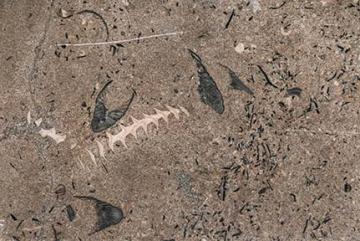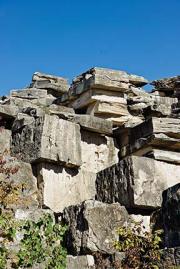
Capitol Built With Missouri Limestone

The Missouri State Capitol was constructed between 1913 and 1917. The exterior and interior of the building were built from limestone that was quarried, shaped and dressed in southwestern Missouri at Carthage, in Jasper County, and Phenix, in northwestern Greene County. The limestone in the Capitol’s interior is polished to a glossy, reflective finish. During the construction of the interior, the polished Missouri limestone gained the distinction of being called “marble.”
What is Marble?
Marble is calcium carbonate (CaCO3) rock that takes a polish and can be used as architectural and decorative stone. Two kinds of rock qualify for use as marble – limestone and true marble. Limestone is a sedimentary rock that may contain fossils. True marble is a metamorphic rock that forms when limestone is subjected to elevated temperatures and pressures in Earth’s crust. True marble typically contains no fossils because the metamorphic process obliterates them from the rock. The marble-like rock in the Missouri State Capitol was cut from fossiliferous limestone, and is polished to a glossy, reflective finish. True marble is not known to occur in Missouri.
Capitol Limestone Formed in Ancient Sea

The Phenix stone came from the Burlington-Keokuk Limestone sedimentary rock unit. The Carthage stone came from the Warsaw Formation sedimentary rock unit. Geologic formations typically are named for the geographic area in which they were first described. Burlington-Keokuk gets its name from Iowa cities and the Warsaw for the city of Warsaw, located in Benton County. The Warsaw Formation immediately overlies the Burlington-Keokuk. Both were formed in a warm, shallow, equatorial sea that covered Missouri during what geologists identify as the Mississippian Subperiod of geologic time, about 335 million years ago. Fine particles of calcium carbonate constantly precipitated from the seawater and eventually accumulated on the seafloor as lime mud.
The sea teemed with invertebrate life forms, including corals, bryozoans, brachiopods, snails, clams and crinoids. The hard parts of dead organisms also accumulated on the seafloor and mixed with the lime mud. Over time, this layer of sediment measured 50 feet thick, or greater. Further burial beneath hundreds of feet of sediment caused the lime mud to compact and turn into a limestone that contains many fossils.
Countless Fossils on Permanent Display
The Missouri limestone used in the Capitol provides an excellent glimpse into the abundant marine animals that once lived in Missouri. Countless fossils are embedded in the marble in the walls and floors, the rotunda, the treads of the stairway and on the exterior of this majestic building. Take a tour of the Capitol and see some of the fossils.
Missouri’s Robust Limestone Industry

Limestone has been utilized for construction purposes since the settlement of the state. Missouri’s robust limestone industry has mined the rock and processed it into a variety of useful products, including building stone, for Missouri, the nation and the world. Limestone has numerous other uses that range from agricultural applications to construction materials to medicines. It is the state’s most abundant commercial mineral. The production of limestone contributes about $1 billion annually to Missouri’s economy.
Further reading
